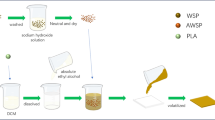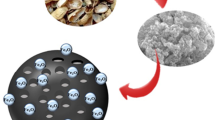Abstract
In order to obtain super synergy effect between adsorption and Fenton oxidation for crystal violet (CV) removement from water, in this study, Fe modified on a sponge structure peanut shell carbon (Fe/SPSC) nanocomposite was successfully synthesized by a wet impregnation method. In the Fe/SPSC sample, the prepared peanut shell carbon had a sponge-like structure, (002) crystal plane of graphite crystallite, and Fe/SPSC composite coexisted Fe2O3 and Fe3O4 crystalline, which could adsorb and enrich crystal violet molecule, decrease the concentration of CV solution rapidly. And also SPSC could do better for electrons transfer and further promote CV oxidation degradation. The removal efficiency results showed that the 7% Fe/SPSC (500 °C, 2 h) had the best CV removal activity. The composite prepared under the optimum conditions is 2.0 g/L, 0.1 mL 30% H2O2, pH = 7.0, 300 mg/L crystal violet water solution, and the CV degradation rate can reach 95.5%, and the CV degradation amount for Fe/SPSC was 143.25 mg/g. It was confirmed that hydroxyl radicals (•OH) is the active center of Fenton oxidation degradation reaction. XPS results showed that Fe, O, and C elements coexist in the 7% Fe/SPSC composite, and N element content increases after the reaction. Remarkable synergies between adsorption and Fenton oxidation, which could make Fe/SPSC, have quick CV abatement ability. The possible systematic effect mechanism of adsorption and Fenton-oxidation CV was also supplied. The present system has advantages on high CV dye degradation performance, no other Fe sludge formation, short reaction time, and better catalyst reusability.


















Similar content being viewed by others
Data availability
All data generated or analyzed during this study are included in this published article.
References
Arslan S, Eyvaz M, Gürbulak E (2016) A review of state-of-the-art technologies in dye-containing wastewater treatment–the textile industry case. TWT 1–29. https://doi.org/10.5772/64140
Babuponnusami A, Muthukumar K (2014) A review on Fenton and improvements to the Fenton process for wastewater treatment. J Environ Chem Eng 2(1):557–572. https://doi.org/10.1016/j.jece.2013.10.011
Campos NF, Sales DCS, Rodríguez-Díaz JM, Barbosa CMBM, Duarte MMMB (2022) Adsorption of naphthenic acids on peanut shell activated carbon: Batch and fixed-bed column study of the process. Chem Eng Res Des 188:633–644. https://doi.org/10.1016/j.cherd.2022.10.023
Chakraborty S, Chowdhury S, Saha PD (2011) Adsorption of crystal violet from aqueous solution onto NaOH-modified rice husk. Carbohydr Polym 86(4):1533–1541. https://doi.org/10.1016/j.carbpol.2011.06.058
Chen CC, Chen WC, Chiou MR (2011) Degradation of crystal violet by an FeGAC/H2O2 process. J Hazard Mater 196:420–425. https://doi.org/10.1016/j.jhazmat.2011.09.042
Chen ZX, Wang T, Jin XY (2013) Multifunctional kaolinite-supported nanoscale zero-valent iron used for the adsorption and degradation of crystal violet in aqueous solution. J Colloid Interf Sci 3989:59–66. https://doi.org/10.1016/j.jcis.2013.02.020
Ersöz G (2014) Fenton-like oxidation of Reactive Black 5 using rice husk ash based catalyst. Appl Catal B 147:353–358. https://doi.org/10.1016/j.apcatb.2013.09.021
Fang D, He F, Xie JL (2020) Calibration of binding energy positions with C1s for XPS results. J Wuhan Univ Technol 35(4):711–718. https://doi.org/10.1007/s11595-020-2312-7
Fayazi M (2021) Preparation and characterization of carbon nanotubes/pyrite nanocomposite for degradation of methylene blue by a heterogeneous Fenton reaction. J Taiwan Inst Chem E 120:229–235. https://doi.org/10.1016/j.jtice.2021.03.033
Fayazi M, GhaneiMotlagh M (2019) Electrochemical mineralization of methylene blue dye using electro Fenton oxidation catalyzed by a novel sepiolite/pyrite nanocomposite. Int J Environ 17:4541–4548. https://doi.org/10.1007/s13762-020-02749-2
Fayazi M, Ghanei-Motlagh M (2021) Enhanced performance of adsorptive removal of dibenzothiophene from model fuel over copper (II)-alginate beads containing polyethyleneterephthalate derived activated carbon. J Colloid Interface Sci 604:517–525. https://doi.org/10.1016/j.jcis.2021.07.035
Fayazi M, Taher MA, Afzali D, Mostafavi A (2016) Enhanced Fenton-like degradation of methylene blue by magnetically activated carbon/hydrogen peroxide with hydroxylamine as Fenton enhancer. J Mol Liq 216:781–787. https://doi.org/10.1016/j.molliq.2016.01.093
Gao QX, Wang XF, Di JL (2011) Enhanced catalytic activity of α-Fe2O3 nanorods enclosed with 110 and 001 planes for methane combustion and CO oxidation. Catal Sci Technol 1(4):574–577. https://doi.org/10.1039/c1cy00080b
Guo T, Jiang LS, Wang K, Li Y, Huang HX, Wu XY, Zhang GK (2021) Efficient persulfate activation by hematite nanocrystals for degradation of organic pollutants under visible light irradiation: Facet-dependent catalytic performance and degradation mechanism. Appl Catal B 286:119883. https://doi.org/10.1016/j.apcatb
Guz L, Curutchet G, Sanchez RMT (2014) Adsorption of crystal violet on montmorillonite (or iron modified montmorillonite) followed by degradation through Fenton or photo-Fenton type reactions. J Environ Chem Eng 2(4):2344–2351. https://doi.org/10.1016/j.jece.2014.02.007
Guzman-Duque F, Pétrier C, Pulgarin C (2011) Effects of sonochemical parameters and inorganic ions during the sonochemical degradation of crystal violet in water. Ultrason Sonochen 18(1):440–446. https://doi.org/10.1016/j.ultsonch.2010.07.019
Hammad M, Fortugno P, Hardt S (2021) Large-scale synthesis of iron oxide/graphene hybrid materials as highly efficient photo-Fenton catalyst for water remediation. Environ Technol Innov 21:101239. https://doi.org/10.1016/j.eti.2020.101239
Hou LW, Wang LG, Royer S (2016) Ultrasound-assisted heterogeneous Fenton-like degradation of tetracycline over a magnetite catalyst. J Hazard Mater 302:458–467. https://doi.org/10.1016/j.jhazmat.2015.09.033
Huang RX, Fang ZQ, Yan XM (2012) Heterogeneous sono-Fenton catalytic degradation of bisphenol A by Fe3O4 magnetic nanoparticles under neutral condition. Chem Eng 197:242–249. https://doi.org/10.1016/j.cej.2012.05.035
Kim HE, Lee J, Lee HS, Lee G (2012) Synergistic effects of TiO2 photocatalysis in combination with Fenton-like reactions on oxidation of organic compounds at circumneutral pH. Appl Catal B Environ 115–116:219–224. https://doi.org/10.1016/j.apcatb.2011.12.027
Kong XQ, Li JY, Yang CW (2020) Fabrication of Fe2O3/g-C3N4@ N-TiO2 photocatalyst nanotube arrays that promote bisphenol A photodegradation under simulated sunlight irradiation. Sep Purif Technol 248:116924. https://doi.org/10.1016/j.seppur.2020.116924
Li M, Qiu JH, Xu J (2020) Cellulose/TiO2-based carbonaceous composite film and aerogel for highly efficient photocatalysis under visible light. Ind Eng Chem Res 59(31):13997–14003. https://doi.org/10.1021/acs.iecr.0c01682
Li B, Xu YH, Liu YL, Dong LM, Komarneni S (2022) Fabricating an oxygen-vacancy-rich urchin-like Co3O4 nanocatalyst to boost peroxymonosulfate activation to degrade high-concentration crystal violet. Ceram Int 48:26553–26564. https://doi.org/10.1016/j.ceramint.2022.05.351
Liu JW, Du YF, Sun WY (2019) Preparation of new adsorbent-supported Fe/Ni particles for the removal of crystal violet and methylene blue by a heterogeneous Fenton-like reaction. Rsc Adv 9(39):22513–22522. https://doi.org/10.1039/c9ra04710g
Matta R, Hanna K, Chiron S (2007) Fenton-like oxidation of 2, 4, 6-trinitrotoluene using different iron minerals. Sci Total Environ 385(1–3):242–251. https://doi.org/10.1016/j.scitotenv.2007.06.030
Mittal A, Mittal J, Malviya A (2010) Adsorption of hazardous dye crystal violet from wastewater by waste materials. J Colloid Interf Sci 343(2):463–473. https://doi.org/10.1016/j.jcis.2009.11.060
Modarresi-Motlagh S, Bahadori F, Ghadiri M (2021) Enhancing Fenton-like oxidation of crystal violet over Fe/ZSM-5 in a plug flow reactor. React Kinet Mech Cat 133(2):1061–1073. https://doi.org/10.1007/s11144-021-02001-z
Morshed MN, Behary N, Bouazizi N (2020) Modification of fibrous membrane for organic and pathogenic contaminants removal: from design to application. Rsc Adv 10(22):13155–13173. https://doi.org/10.1039/d0ra01362e
Navalon S, Dhakshinamoorthy A, Alvaro M (2011) Heterogeneous Fenton catalysts based on activated carbon and related materials. Chemsuschem 4(12):1712–1730. https://doi.org/10.1002/cssc.201100216
Navalon S, Sempere D, Alvaro M, Garcia H (2013) Influence of hydrogen annealing on the photocatalytic activity of diamond-supported gold catalysts. Acs Appl Mater Inter 5(15):7160–7169. https://doi.org/10.1021/am401489n
Palas B, Ersöz G, Atalay S (2016) Heterogeneous photo Fenton-like oxidation of Procion Red MX-5B using walnut shell based green catalysts. J Photochem Photobiol A 32:165–174. https://doi.org/10.1016/j.jphotochem.2016.03.031
Palma-Goyes RE, Guzmán-Duque FL, Peñuela G (2010) Electrochemical degradation of crystal violet with BDD electrodes: effect of electrochemical parameters and identification of organic by-products. Chemosphere 81(1):26–32. https://doi.org/10.1016/j.chemosphere.2010.07.020
Rai P, Gautam RK, Banerjee S (2015) Synthesis and characterization of a novel SnFe2O4@ activated carbon magnetic nanocomposite and its effectiveness in the removal of crystal violet from aqueous solution. J Environ Chem Eng 3(4):2281–2291. https://doi.org/10.1016/j.jece.2015.08.017
Ren M, Qian XF, Fang MY (2018) Ferric (hydr) oxide/mesoporous carbon composites as Fenton-like catalysts for degradation of phenol. Res Chem Intermediat 44(7):4103–4117. https://doi.org/10.1007/s11164-018-3358-4
Rubeena KK, Reddy PHP, Laiju AR (2018) Iron impregnated biochars as heterogeneous Fenton catalyst for the degradation of acid red 1 dye. J Environ Manag Ge 226:320–328. https://doi.org/10.1016/j.jenvman.2018.08.055
Saquib M, Muneer M (2003) TiO2-mediated photocatalytic degradation of a triphenylmethane dye (gentian violet), in aqueous suspensions. Dyes Pigments 56(1):37–49. https://doi.org/10.1016/s0143-7208(02)00101-8
Sun ZM, Xiao C, Hussain F (2018) Synthesis of stable and easily recycled ferric oxides assisted by Rhodamine B for efficient degradation of organic pollutants in heterogeneous photo-Fenton system. J Clean Prod 196:1501–1507. https://doi.org/10.1016/j.jclepro.2018.06.122
Ünnü BA, Gündüz G, Dükkancı M (2016) Heterogeneous Fenton-like oxidation of crystal violet using an iron loaded ZSM-5 zeolite. Desalin Water Treat 57(25):11835–11849. https://doi.org/10.1080/19443994.2015.1044915
Wang JL, Tang JT (2021) Fe-based Fenton-like catalysts for water treatment: catalytic mechanisms and applications. J Mol Liq 332:115755. https://doi.org/10.1016/j.molliq.2021.115755
Wang YB, Zhao HY, Zhao GH (2015) Iron-copper bimetallic nanoparticles embedded within ordered mesoporous carbon as effective and stable heterogeneous Fenton catalyst for the degradation of organic contaminants. Appl Catal B-Environ 164:396–406. https://doi.org/10.1016/j.apcatb.2014.09.047
Wang JB, Zhi D, Zhou H (2018) Evaluating tetracycline degradation pathway and intermediate toxicity during the electrochemical oxidation over a Ti/Ti4O7 anode. Water Res 137:324–334. https://doi.org/10.1016/j.watres.2018.03.030
Wang ZZ, Jiang LS, Wang K, Li Y, Zhang GK (2021) Novel AgI/BiSbO4 heterojunction for efficient photocatalytic degradation of organic pollutants under visible light: Interfacial electron transfer pathway, DFT calculation and degradation mechanism study. J Hazard Mater 410:124948. https://doi.org/10.1016/j.jhazmat
Wu J, Gao H, Yao S (2015) Degradation of crystal violet by catalytic ozonation using Fe/activated carbon catalyst. Sep Purif Cation Technol 147:179–185. https://doi.org/10.1016/j.seppur.2015.04.022
Yang ZC, Yu AQ, Shan C (2018) Enhanced Fe (III)-mediated Fenton oxidation of atrazine in the presence of functionalized multi-walled carbon nanotubes. Water Res 137:37–46. https://doi.org/10.1016/j.watres.2018.03.006
Yang ZX, Wang ZZ, Wang JT, Li Y, Zhang GK (2022) Facet-dependent activation of oxalic acid over magnetic recyclable Fe3S4 for efficient pollutant removal under visible light irradiation: enhanced catalytic activity, DFT calculations, and mechanism Insight. Environ Sci Technol 56:18008–18017. https://doi.org/10.1021/acs.est.2c06571
Yi YQ, Tu GQ, Ying GG (2021) Magnetic biochar derived from rice straw and stainless steel pickling waste liquor for highly efficient adsorption of crystal violet. Bioresour Technol 341:125743. https://doi.org/10.1016/j.biortech.2021.125743
Zhang XW, Zhang T, Ng JW, Pan JH, Sun DD (2010) Transformation of bromine species in TiO2 photocatalytic system. Environ Sci Technol 44(1):439–444. https://doi.org/10.1021/es902592w
Zhang GQ, Zhou YF, Yang FL (2015) FeOOH-catalyzed heterogeneous electro-Fenton system upon anthraquinone@graphene nanohybrid cathode in a divided electrolytic cell: catholyte-regulated catalytic oxidation performance and mechanism. J Electrochem Soc 162(6):H357–H365. https://doi.org/10.1149/2.0691506jes
Zheng XP, Wen FW, Zhao JH, Chen ZT, Chen CT, Zheng Y (2012) Uhplc-ms/ms determination of residual amounts of malachite green, crystal violet and their metabolites in aquatic products. J Aoac Int 48(2):162–164. https://doi.org/10.5740/jaoacint.13-142
Zhou LC, Ma JJ, Zhang H (2015) Fabrication of magnetic carbon composites from peanut shells and its application as a heterogeneous Fenton catalyst in removal of methylene blue. Appl Surf Sci 324:490–498. https://doi.org/10.1016/j.apsusc.2014.10.152
Funding
This study was supported by the Joint Project of Basic Agricultural Research Fund of Yunnan Province (2018FG001-051) and Open fund of Key Laboratory of State Forestry and Grassland Administration on Highly-Efficient Utilization of Forestry Biomass Resources in Southwest China (2022-KF06), This work was also supported by the National Natural Science Foundation of China (31860155).
Author information
Authors and Affiliations
Contributions
Minghui Wu contributed significantly to analysis and manuscript preparation. Shuang Li contributed to make the graphs in the manuscript. Shiping Zhou helped perform the analysis with constructive discussions. Fengchuan Li performed the experiment. Tao Li performed the data analyses. Huijuan Li contributed to the conception of the study and wrote the manuscript. All authors read and approved the final manuscript.
Corresponding author
Ethics declarations
Ethics approval
Not applicable.
Consent to participate
Not applicable.
Consent for publication
Not applicable.
Competing interests
The authors declare no competing interests.
Additional information
Responsible Editor: Ricardo A. Torres-Palma
Publisher's Note
Springer Nature remains neutral with regard to jurisdictional claims in published maps and institutional affiliations.
Rights and permissions
Springer Nature or its licensor (e.g. a society or other partner) holds exclusive rights to this article under a publishing agreement with the author(s) or other rightsholder(s); author self-archiving of the accepted manuscript version of this article is solely governed by the terms of such publishing agreement and applicable law.
About this article
Cite this article
Wu, M., Li, S., Zhou, S. et al. Fe/sponge structure peanut shell carbon composite preparation for efficient Fenton oxidation crystal violet. Environ Sci Pollut Res 30, 105457–105473 (2023). https://doi.org/10.1007/s11356-023-29828-4
Received:
Accepted:
Published:
Issue Date:
DOI: https://doi.org/10.1007/s11356-023-29828-4




